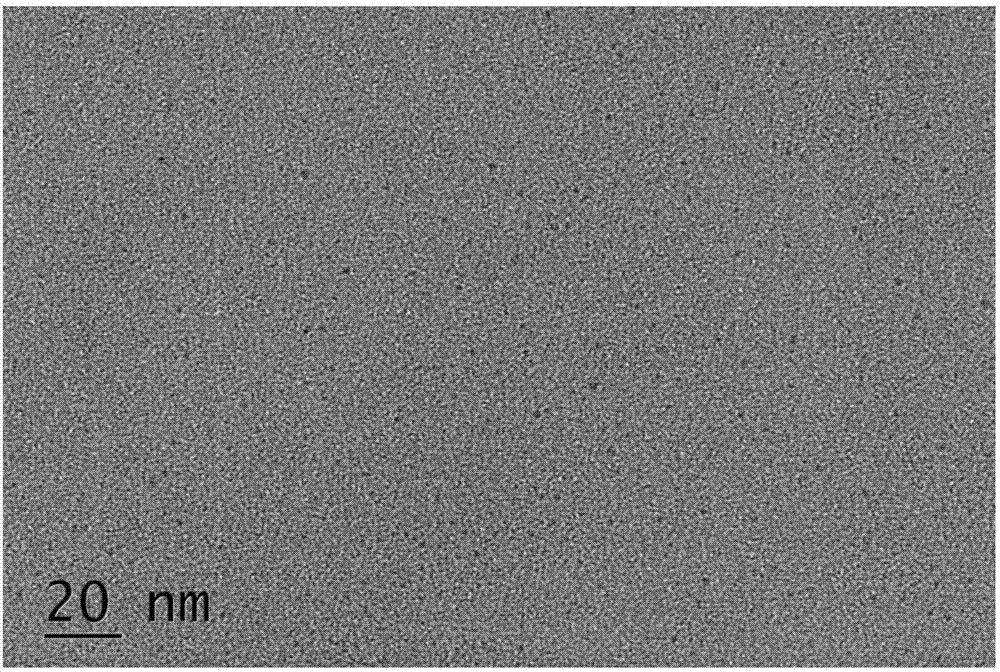A method for quantitative detection of biological molecules capable of being metabolized to generate H2O2 in serum by means of a ratiometric fluorescent probe
A ratio fluorescent probe, H2O2 technology, applied in the field of fluorescence ratio technology and bioanalysis detection, nanomaterials
- Summary
- Abstract
- Description
- Claims
- Application Information
AI Technical Summary
Problems solved by technology
Method used
Image
Examples
Embodiment 1
[0027] Example 1 Preparation of copper-nitrogen co-doped carbon dots (Cu-CDs)
[0028] Dissolve 1.2g of citric acid monohydrate and 0.15g of copper acetate monohydrate in 20mL of deionized water, sonicate for 15min to fully dissolve; add 0.15mL of diethylenetriamine to the mixed solution in the previous step, and sonicate for 15min to fully mix ;Transfer the above solution to a 30mL autoclave, and react at 230°C for 12h; after the reaction is completed, cool it to room temperature, take out the product and add 0.1M NaOH to adjust the pH to about 7.0, dialyze with a 1000Da dialysis bag for 72h, and replace the dialysate at an interval of about 3-6 hours; after the dialysis is completed, the product is distilled and concentrated under reduced pressure to obtain a dark brown solution, dried in vacuum at 60°C to obtain a brown powder, which is sealed and stored for later use. Its TEM and XPS pictures are as follows figure 1 , 2 As shown, its fluorescence and UV absorption diagra...
Embodiment 2
[0030] Embodiment 2 Take cholesterol as an example to illustrate the detection method of the present invention
[0031] 1. Catalyze the reaction of cholesterol to generate H 2 o 2 , and further catalyzes H 2 o 2 React with OPD to generate yellow fluorescent DAP, the steps are as follows: Take 1 mL of cholesterol with different concentrations (0, 0.05, 0.1, 0.25, 1.0, 2.5, 10, 30, 75, 100, 150, 250, 400, 600, 800, 1000 μM ), add 10 μL of cholesterol oxidase (concentration: 5.0 mg / mL), shake and mix thoroughly; take out 200 μL of the mixed solution into a 2 mL EP tube, add 200 μL of 14 mM OPD (containing 10 μg / mL HRP), mix well, and react at 37 °C for 30 min. The pH of the solution is 6.6, and it is prepared with a 20mM phosphate buffer system.
[0032] 2. Add Cu-CDs and DAP to form ratio fluorescence, and quantitatively measure the amount of biomolecule cholesterol in serum: the concentration of Cu-CDs is 200 μg / mL, and it is prepared with 20 mM, pH=6.6 phosphate buffer sys...
Embodiment 3
[0033] Embodiment 3 Take xanthine as an example to illustrate the detection method of the present invention:
[0034] 1. Catalyze the reaction of xanthine to generate H 2 o 2 , and further catalyzes H 2 o 2 React with OPD to generate yellow fluorescent DAP, the steps are as follows: take different concentrations of xanthine (0, 0.25, 0.75, 1.5, 5, 15, 30, 75, 150, 250, 400, 600, 800, 1000μM) 1mL, add 10μL Bilixanthine oxidase (concentration: 5.0 mg / mL), shake and mix thoroughly; take 200 μL of the mixed solution into a 2 mL EP tube, add 200 μL of 14 mM OPD (containing 10 μg / mL HRP), mix well, and react at 37 ° C for 30 min. The pH of the solution is 6.6, and it is configured with a 20mM phosphate buffer system.
[0035] 2. Add Cu-CDs and DAP to form ratio fluorescence, quantitatively measure biomolecule xanthine in serum, the remaining steps are the same as in Example 2, see the results Figure 7 , 8 shown.
PUM
 Login to View More
Login to View More Abstract
Description
Claims
Application Information
 Login to View More
Login to View More - R&D
- Intellectual Property
- Life Sciences
- Materials
- Tech Scout
- Unparalleled Data Quality
- Higher Quality Content
- 60% Fewer Hallucinations
Browse by: Latest US Patents, China's latest patents, Technical Efficacy Thesaurus, Application Domain, Technology Topic, Popular Technical Reports.
© 2025 PatSnap. All rights reserved.Legal|Privacy policy|Modern Slavery Act Transparency Statement|Sitemap|About US| Contact US: help@patsnap.com



